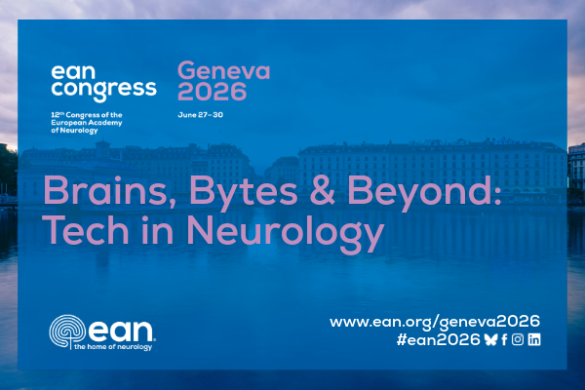by Elena Moro
For April 2019, we have selected: Kellinghaus C, Rossetti AO, Trinka E, et al. Factors predicting cessation of status epilepticus in clinical practice: Data from a prospective observational registry (SENSE). Ann Neurol 2019;85:421-432.
Status epilepticus (SE) is a common neurological emergency. Although international and national guidelines regarding its treatment are largely available, data about their real implementation in the European clinical practice are scarce.
In this study, the authors collected data coming from a large, prospective, observational, European registry for patients treated for SE (SENSE, Sustained Effort Network for treatment of Status Epilepticus). SENSE includes data about treatment at any stage of generalized convulsive status epilepticus (GCSE) and non-GCSE from eight medical centers between Germany, Austria, and Switzerland. The main objective of the study was to investigate predictive factors of SE resolution within the first hour for GCSE, and within the initial 12 hours for non-GCSE patients.
From January 2011 to June 2015, a total of 1,049 patients were included in SENSE (1,179 episodes of SE). GCSE patients were 457 and non-GCSE were 592. The median age at SE onset was 70 years (range, 54-80), and 51% were women. Treatment was initiated within 30 minutes in 221/457 GCSE patients (48%), and in 112/592 non-GCSE patients (19%), with a median latency between SE onset and treatment of 30 min (range, 25-240) in GCSE, and of 150 min (range, 45-420) in non-GCSE.
As first treatment step, benzodiazepines were most frequently used, and successful in 21% of GCSE (98), and 16% of non-GCSE (93) patients. Levetiracetam was used in 6% of GCSE (28), and in 22% of non-GCSE (130) subjects. As second treatment step, levetiracetam was the most frequently used (227 GCSE and 307 non-GCSE patients), followed by valproate. Overall, the second treatment step was administered after a median of 30 min from the first treatment in 359 GCSE and in 499 non-GCSE patients, and it was successful in 46% and 38% of the GCSE and non-GCSE patients, respectively.
The IV medication bolus doses were largely lower than recommended by currently available guidelines. Cumulative standardized bolus doses applied in the first 0.5, 2, and 12 hours of treatment were lower (p<0.001) in refractory compared to non-refractory GCSE and non-GCSE patients. A higher proportion of non-GCSE patients was intubated during treatment (p<0.001).
Overall, SE ceased within the first 30 min after treatment in 24% GCSE and in 15% non-GCSE patients, after 2 hours in 20% GCSE and 13% non-GCSE, and after 12 hours in 21% and 17% of GCSE and non-GCSE patients, respectively. In-hospital mortality was 9% (43 patients) in GCSE, and 19% (114 patients) in non-GCSE.
In GCSE patients, prognostic factors of successful treatment within 1 hour were younger age (p=0.01), the use benzodiazepine as first treatment (p=0.04), higher standardized cumulative dose of antiepileptic drugs within the first 30 min of treatment (p=0.002), and shorter treatment latency (p=0.04). In non-GCSE patients, successful treatment within 12 hours was associated with lower number of comorbidities (p=0.004), the use of benzodiazepine as first drug (p<0.001), a higher cumulative standardized dose within the first 60 min (p=0.002), and lower Status Epilepticus Severity Score (p<0.001).
“This is a very informative study concerning the real practical and current treatment of status epilepticus in Europe, or at least in some European countries”, says Prof. Philippe Kahane, Division of Neurology, Grenoble Alpes University, Grenoble, France. “The main point is that there is still insufficient training about how to treat SE, although guidelines do exist. This is surprising since the three countries involved in the study are usually rigorous in applying guidelines. Such guidelines support the use of high doses of benzodiazepine as first line treatment, and data coming from this study clearly show that even if this approach is very effective it is not widely used. Such a study should encourage other countries to analyze their treatment practices for SE, the morbidity, and the mortality which remain (too) high. ”
“This study also shows that time to treatment, cumulative weight-adjusted does of anticonvulsants, age, and comorbidities are all important factors influencing the early cessations of SE, and thus a more favorable recovery. It mirrors the Value of Treatment report of the European Brain Council (2017) identifying a treatment gap in Europe. Having guidelines is only half of the way, implementing it in clinical practice is necessary to achieve the full benefit for our patients. ”, says PD Dr Tim von Oertzen, Department of Neurology, University of Linz, Austria. “Therefore, modifiable important factors like early treatment and optimized medication dose play an essential role in SE management. More efforts should be made to improve European clinical practice with SE treatment.”
The other nominees for the April 2019 Paper of the month are:
- De Greef BTA, Hoeijmakers JGJ, Geerts M, et al. Lacosamide in patients with Nav1.7 mutations-related small fibre neuropathy: a randomized controlled trial. Brain 2019;142:263-275. The potential effects of lacosamide as a potential treatment for pain in Nav1.7-related small fibre neuropathy was study in this 8-week randomized, placebo-controlled, double-blind trial. In about 60% of the 24 patients who received locosamide, there was a significant reduction of pain. The lacosamide group reported also general condition and sleep improvement, together with a good tolerability profile.
- Wolfe GI, Kaminski HJ, Aban IB, et al., on behalf of the MGTX Study Group. Long-term effect of thymectomy plus prednisone versus prednisone alone in patients with non-thymomatous myasthenia gravis: 2-year extension of the MGTX randomized trial. Lancet Neurol 2019;18:259-268. Sixty-eight out of 110 patients were included in this rater-blinded 2-year extension of the 3-year MGTX study, 33 from the prednisone alone group and 35 from the prednisone-plus thymectomy group. At 5 year, the prednisone-plus thymectomy patients had an overall better outcome compared to the prednisone only patients.
- Fralick M, Sy E, Hassan A, Burke MJ, Mostofsky E, Karsies T. Association of concussion with the risk of suicide. A systemic review and meta-analysis. JAMA Neurol 2019;76:144-151. In this review, the authors analyze the risk of suicide after concussion. Data coming from 10 cohort’s studies, 5 cross-sectional studies and 2 case-control studies showed that experiencing concussion and/or mild traumatic brain injury was associated with higher risk of suicide. Concussion was also associated with higher risk of suicide attempts.
- Markus HS, Levi C, King A, Madigan J, Norris J, for the Cervical Artery Dissection in Stroke (CADISS) Investigators. Antiplatelet therapy vs anticoagulation therapy in cervical artery dissection. The Cervical Artery Dissection in Stroke Study (CADISS) randomized clinical trial final results. JAMA Neurol. doi:10.1001/jamaneurol.2019.0072. This study was designed to assess the efficacy in recurrent stroke prevention between antiplatelet and anticoagulation therapy in patients with cervical artery dissection. At one-year follow-up, 250 patients with extracranial carotid and vertebral artery dissection with symptoms onset within the last 7 days were included in the data analysis. No significant difference was found between groups in the recurrent stroke rate (which was low) at 1 year.
Prof. Elena Moro is Editor in Chief of EAN Pages and treasurer of EAN as well as Director of the Movement Disorders Center at the Centre Hospital Universitaire (CHU) of Grenoble, France and the Associate Director of the CHU Department of Psychiatry, Neurology and Rehabilitation.












